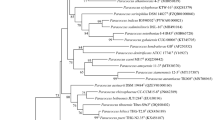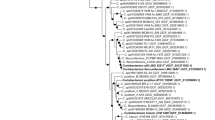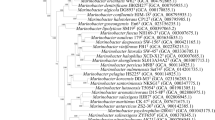Abstract
A novel casein hydrolysing bacterium designated strain S-52T was isolated from Kyonggi University forest soil. Cells were strictly aerobic, Gram stain-negative, oxidase- and catalase- positive, non-motile, non-spore-forming, rod-shaped, and golden-yellow-pigmented. Strain S-52T hydrolysed casein. It was able to grow at 20–37 °C (optimum 25–32 °C), pH 6.5–11.0 (optimum 7–9.5), and at 3% (w/v) NaCl concentration. Strain exhibits flexirubin-type pigments. Phylogenetic analysis based on 16S rRNA gene sequence revealed that strain S-52T formed a lineage within the genus Chitinophaga that was distinct from other species of the genus. Closest member was Chitinophaga barathri YLT18T (97.16% 16 S rRNA gene sequence similarity). The major cellular fatty acids were iso-C15:0, C16:1ω5c, iso-C17:0 3-OH, and summed feature 3 (C16:1ω7c and/or C16: 1ω6c). MK-7 was sole respiratory quinone. The major polar lipid was phosphatidylethanolamine. The DNA G + C content of strain S-52T was 48.8 mol%. DNA–DNA relatedness of strain S-52T with Chitinophaga barathri was 42.5%. On the basis of phenotypic, genotypic, phylogenetic, and chemotaxonomic characterization, S-52T represents a novel species in the genus Chitinophaga, for which the name Chitinophaga caseinilytica sp. nov. is proposed. The type strain is S-52T (= KEMB 9005-540T = KACC 19118T = NBRC 112679T).

Similar content being viewed by others
References
Breznak JA, Costilow RN (2007) Physicochemical factors in growth. In: Beveridge TJ, Breznak JA, Marzluf GA, Schmidt TM, Snyder LR (eds) Methods for general and molecular bacteriology, 3rd edn. American Society for Microbiology, Washington, DC, pp 309–329
Cheng HR, Jiang N (2006) Extremely rapid extraction of DNA from bacteria and yeasts. Biotechnol Lett 28:55–59
Dahal RH, Kim J (2017)) Microvirga soli sp. nov., a novel alphaproteobacterium isolated from soil. Int J Syst Evol Microbiol 67:127–132
Doetsch RN (1981) Determinative methods of light microscopy. In: Gerhardt P (ed) Manual of methods for general bacteriology. American Society for Microbiology, Washington, DC, pp 21–33
Ezaki T, Hashimoto Y, Yabuuchi E (1989) Fluorometric DNA-DNA hybridization in microdilution wells as an alternative to member filter hybridization in which radioisotopes are used to determine genetic relatedness among bacterial strains. Int J Syst Evol Microbiol 39:224–229
Felsenstein J (1981) Evolutionary trees from DNA sequences: a maximum likelihood approach. J Mol Evol 17:368–376
Felsenstein J (1985) Confidence limits on phylogenies: an approach using the bootstrap. Evolution 39:783–791
Fitch WM (1971) Toward defining the course of evolution: minimum change for a specific tree topology. Syst Zool 20:406–416
Frank JA, Reich CI, Sharma S, Weisbaum JS, Wilson BA, Olsen GJ (2008) Critical evaluation of two primers commonly used for amplification of bacterial 16S rRNA gene. Appl Environ Microbiol 74:2461–2470
Hall TA (1999) BioEdit: a user-friendly biological sequence alignment editor and analysis program for Windows 95/98/NT. Nucleic Acids Symp Ser 41:95–98
Kämfer P, Young CC, Sridhar KR, Arun AB, Lai WA, Shen FT, Rekha PD (2006) Transfer of [Flexibacter] sancti, [Flexibacter] filiformis, [Flexibacter] japonensis and [Cytophaga] arvensicola to the genus Chitinophaga and description of Chitinophaga skermanii sp. nov. Int J Syst Evol Microbiol 56:2223–2228
Kämfer P, Lodders N, Falsen E (2011) Hydrotalea flava gen. n ov., sp. nov., a new member of the phylum Bacteroidetes and allocation of the genera Chitinophaga, Sediminibacterium, Lacibacter, Flavihumibacter, Flavisolibacter, Niabella, Niastella, Segetibacter, Parasegetibacter, Terrimonas, Ferruginibacter, Filimonas and Hydrotalea to the family Chitinophagaceae fam. nov. Int J Syst Evol Microbiol 61:518–523
Kimura M (1980) A simple method for estimating evolutionary rate of base substitutions through comparative studies of nucleotide sequences. J Mol Evol 16:111–120
Komagata K, Suzuki K (1987) Lipids and cell wall analysis in bacterial systematics. Methods Microbiol 19:161–203
Larkin MA, Blackshields G, Brown NP, Chenna R, McGettigan PA, McWilliam H, Valentin F, Wallace IM, Wilm A, Lopez R, Thompson JD, Gibson TJ, Higgins DG (2007) Clustal W and Clustal X version 2.0. Bioinformatics 23:2947–2948
Lee HG, An DS, Im WT, Liu QM, Na JR, Cho DH, Jin CW, Lee ST, Yang DC (2007) Chitinophaga gisengisegetis sp. nov. and Chitinophaga ginsengisoli sp. nov., isolated from soil of a ginseng field in South Korea. Int J Syst Evol Microbiol 57:1396–1401
Mesbah M, Premachandran U, Whitman WB (1989) Precise measurement of the G + C content of deoxyribonucleic acid by high-performance liquid chromatography. Int Syst Bacteriol 39:159–167
Minnikin DE, O’Donnell AG, Goodfellow M, Alderson G, Athalye M, Schaal A, Parlett JH (1984)) An integrated procedure for the extraction of bacterial isoprenoid quinones and polar lipids. J Microbiol methods 2:233–241
Reichenbach H (1992) The order Cytophagales. In: Balows A, Trüper HG, Dworkin M, Harder W, Schleifer KH (eds) The prokaryotes, vol 4, 2nd edn. Springer, New York, pp 3631–3675
Saitou N, Nei M (1987) The neighbour-joining method: a new method for reconstructing phylogenetic trees. Mol Biol Evol 4:406–425
Sangkhobol V, Skerman VBD (1981) Chitinophaga, a new genus of chitinolytic myxobacteria. Int J Syst Bacteriol 31:285–293
Sasser M (1990) Identification of bacteria by gas chromatography of cellular fatty acids. MIDI Inc, MIDI Technical Note 101. Newark, DE
Smibert RM, Krieg NR (1994) Phenotypic characterization. In: Gerhardt P, Murray RGE, Wood WA, Krieg NR (eds) Methods for general and molecular bacteriology. American Society for Microbiology, Washington, DC, pp 607–654
Tamura K, Stecher G, Peterson D, Filipski A, Kumar S (2013) MEGA6: Molecular Evolutionary Genetics Analysis version 6.0. Mol Biol Evol 30:2725–2729
Tindall BJ, Sikorski J, Smibert RA, Krieg NR (2007) Phenotypic characterization and the principles of comparative systematics. In: Reddy CA, Beveridge TJ, Breznak JA, Marzluf GA, Schmidt TM, Snyder LR (eds) Methods for general and molecular bacteriology, 3rd edn. ASM Press, Washington, pp 330–393
Wayne LG, Brenner DJ, Colwell RR, Grimont PAD, Kandler O, Krichevsky MI, Moore LH, Moore WEC, Murray RGE, Stackebrandt E, Starr MP, Trüper HG (1987) Report of the ad hoc committee on reconciliation of approaches to bacterial systematic. Int J Syst Bacteriol 37:463–464
Weon HY, Yoo SH, Kim YJ, Son JA, Kim BY, Kwon SW, Koo BS (2009) Chitinophaga niabensis sp. nov. and Chitinophaga niastensis sp. nov., isolated from soil. Int J Syst Evol Microbiol 59:1267–1271
Yoon SH, Ha SM, Kwon S, Lim J, Kim Y, Seo H, Chun J (2017)) Introducing EzBioCloud: a taxonomically united database of 16S rRNA and whole genome assemblies. Int J Syst Evol Microbiol 67:1613–1617
Zhang L, Liao S, Tan Y, Wang G, Dan W, Zheng S (2015) Chitinophaga barathri sp. nov., isolated from mountain soil. Int J Syst Evol Microbiol 65:4233–4238
Funding
This research was supported by Basic Science Research Program through the National Research Foundation of Korea (NRF) funded by the Ministry of Education (2016R1D1A1A09916982).
Author information
Authors and Affiliations
Corresponding author
Ethics declarations
Conflict of interest
The authors declare that there are no conflicts of interest regarding the publication of this manuscript.
Additional information
Communicated by Erko Stackebrandt.
Electronic supplementary material
Below is the link to the electronic supplementary material.
Rights and permissions
About this article
Cite this article
Dahal, R.H., Kim, J. Chitinophaga caseinilytica sp. nov., a casein hydrolysing bacterium isolated from forest soil. Arch Microbiol 200, 645–651 (2018). https://doi.org/10.1007/s00203-018-1473-7
Received:
Revised:
Accepted:
Published:
Issue Date:
DOI: https://doi.org/10.1007/s00203-018-1473-7




